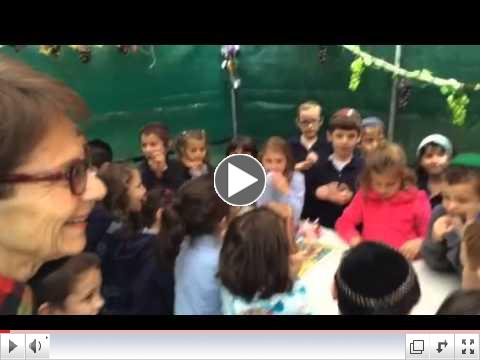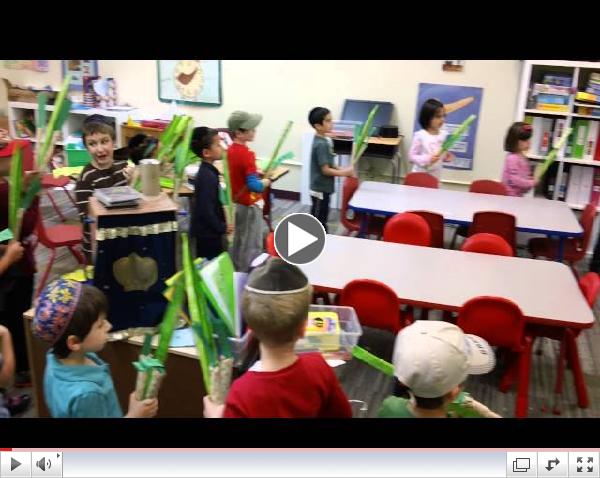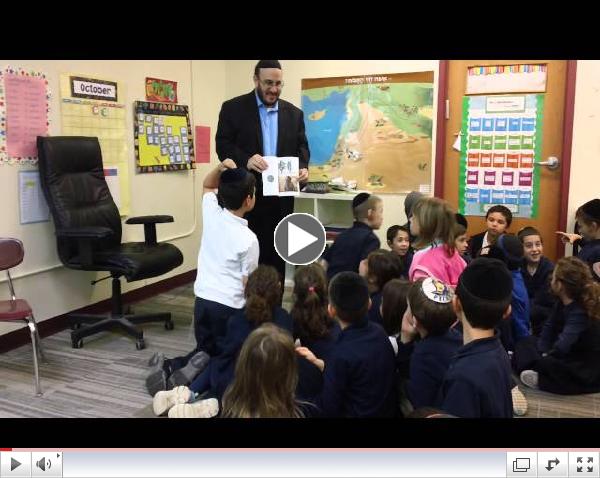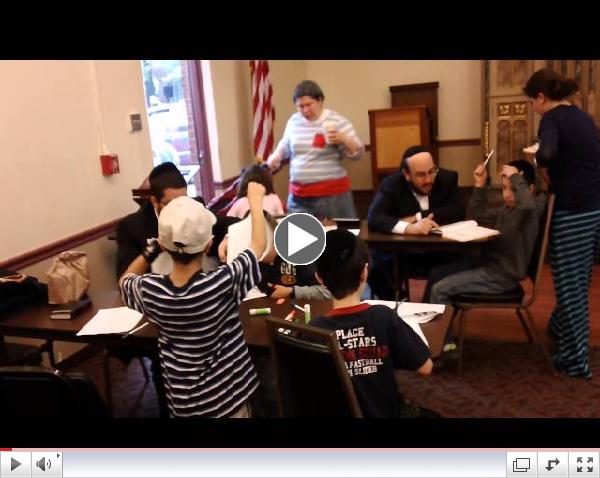|
The Hillel Happenings
The Official e-Newsletter of Hillel Academy of Pittsburgh
|
|
|
|
October 7, 2014
13 Tishrei 5775
Sukkot, Shemini Atzeret, Simchat Torah,
&
Parshat Bereshit
Candle Lighting Time:
Wed. 10/8 - 6:33 pm
Thur. 10/9 - 7:39 pm
Fri. 10/10 - 6:29 pm
Havdallah - 7:36 pm
Wed. 10/15 - 6:22 pm
Thur. 10/16 - 7:28 pm
Fri. 10/17 - 6:19
Havdallah - 7:25 pm

|
|
LETTER FROM THE EDITOR:
by Reb Danny Shaw
As we prepare for Sukkot, we have put together a special edition of the Hillel Happenings focused on Divrei Torah from members of the Hillel Academy family. I hope these essays enhance your Sukkot, and provide a catalyst for Torah discussion in your Sukkah.
There are so many themes during this time of year; the meaning behind the four species, the purpose of dwelling in the Sukkah among others, and one that speaks to me, Simchat Torah. On Simchat Torah, we read the last Parsha of the Torah and immediately, begin the first Parsha. This is a powerful lesson. No matter how many times we finish the Torah we always begin anew. Reviewing what we already know, no matter the subject, is crucial for retention. Each time we review something, we learn something else.
May we all have a wonderful Yom Tov with our families, and continue to grow in all of our endeavors!
Chag Sameach!
|
|
THE ETROG
by Rabbi Sam Weinberg - Head of School
When the Torah first mentions the Mitzva of arba minim (the four species), the verse (Vayikra 23:43) refers to the etrog with the term "pri etz hadar" (the beautiful fruit of the tree). The Talmud in Sukkah (35a) explains how this specific description relates to the etrog. The Talmud suggests that by calling the fruit, the "fruit of the tree," the verse is comparing the fruit to the tree. The Talmud concludes that an etrog's bark must taste the same as the fruit itself. Secondly, in a play on the word "hadar," the Talmud explains that an etrog must stay on the tree all year-round.
Perhaps these two descriptions of the nature of the etrog can help us better understand another medrash, this one found in Parashat Emor. In this medrash, our sages compare the four species to four different types of Jews. The etrog, which is both fragrant and tasty, represents the complete tzaddik. It is possible that the aforementioned qualities of the etrog can also fit in with the symbolism of viewing the etrog as the tzaddik. The requirement of a similar taste for the bark and fruit teaches that a true tzaddik is pious internally and externally. He serves Hashem with the best intentions and his actions match his inner thoughts. This genuineness naturally produces the second trait, consistency. Just like the etrog remains on the branch all year-round, Torah observance for a tzaddik is not a matter of convenience, but a lifelong commitment.
This lesson can also be understood in the connection between the High Holidays of Rosh Hashana, Yom Kippur, and Sukkot. Sukkot finds itself at the end of the "Tishrei" holidays. After we are judged by Hashem on Rosh Hashana and Yom Kippur, we sit in the glory of G-d by sitting in the Sukkah. Throughout our liturgy, Sukkot is described as "z'man simchateinu"- "our time of joy." Even though there is an obligation of simcha on every holiday, the Torah places a particular emphasis of simcha in the context of Sukkot. In essence, we transition from days of awe to days of joy. Perhaps the Torah is emphasizing an important lesson with the juxtaposition of these two themes. After Yom Kippur, we all feel like "etrog Jews." We have spent twenty-five hours in shul, striving to reach the spiritual heights of the tzaddikim among us. The Torah is telling us that just like the etrog is consistent in its mission, so we too must be consistent and not only serve Hashem out of awe and fear, but out of joy as well.
May this year be a year of blessing and joy for all of us, and may we continue to find joy in all aspects of serving Hashem.
|
|
Hillel on YouTube - The Video Center
|
 | |
Hillel Academy first graders went to Beacon Place to sing and bring Sukkot decorations.
|
 | | Hillel Academy kindergarten hoshanot. |
 | | Rabbi Yolkut explains the halachot and origins of etrogim to the Hillel Academy third graders. |
|
|
THE FOUR SPECIES
by Rabbi Yisroel Smith - Vice Principal of the Boys High School
When I was in Yeshiva, my Rebbe, Rabbi Shaya Cohen Shlit"a, gave a weekly teacher training course. I remember one time when he was telling us about the importance of teaching our students that every Mitzvah has a benefit for us in this world. We asked, "Every Mitzvah?" He said, "Try me." Someone said, "What about Lulav and Esrog? What possible benefit can I have from just shaking the 4 species?"
Rabbi Cohen gave the following beautiful insight from the Sefer HaChinuch, by taking a well-known idea and making it very real: The Sefer HaChinuch explains how the 4 species represent four parts of the body. The Lulav represents the spine, the Hadas represents the eyes, the Aravah represents the lips, and the Esrog represents the heart.
Rabbi Cohen explained that we can use this concept to address a problem many of us have: I just don't see myself as someone who is truly dedicated to serving Hashem. Sure I try to do the right thing here and there, but to really be someone who serves Hashem with all he has-that's just not me.
Rabbi Chen said there's a concept known as guided imagery, which is used by athletes, police officers and even some physicians. It's the idea that when you spend time dedicated to visualizing yourself doing something that's difficult, then you have a significantly better chance of accomplishing your goal. Whether it's hitting a baseball or properly handling a criminal, the more I work on seeing myself doing it-the better I will be at it.
Rabbi Cohen explains that when we take the 4 species we are taking a mini-version of ourselves and seeing ourselves serving Hashem. By shaking it in all directions, we are able to watch ourselves do something we normally view as impossible-fully serving Hashem with all we have.
B'ezras Hashem, this Sukkos we should all be successful in taking that image and transferring it into a reality.
|
|
|
|
|
|
|
|
|
|
|
THE FINAL PARSHA OF THE TORAH
by Rabbi Oren Levy - Rebbe and Director of HYPE
In פרשת וזאת הברכה, Moshe blesses the 12 tribes before his death. He begins with a blessing to the tribe of Reuven, "Reuven should live and not die."
In his פירוש on the Torah, Rav Shimshon Rafael Hirsch asks two questions on this pasuk. First, what kind of blessing is Moshe giving to the tribe of Reuven? Upon looking at all the other blessings bestowed upon the tribes by Moshe, one finds beautiful, poetic blessings; gifts of power, prestige and spirituality. However, Reuven is simply blessed to live and not die. How is that possible?
Rav Shimshon continues and asks that upon careful review of the division of the pasukim, it would seem that the blessing of Reuven is connected to the previous pasukim, and not connected to the rest of the blessings! The Torah places a סתומא (small break) between the end of Reuven's blessing and the next tribe's blessing, implying that it is related to the previous pasukim. The previous pasukim begin with the familiar, "תורה צוה לנו משה מורשה קהלת יעקב." "Moshe commanded us the Torah, it is an inheritance to the entire congregation of Yaakov (Israel)." What does Reuven's blessing have to do with this פסוק and why did Moshe disconnect Reuven's blessing from the rest of the tribes?
Rav Shimshon offers a beautiful insight to answer these questions. He explains that Moshe was concerned that the tribe of Reuven would be sad and upset at not having any special inheritance. Originally, the tribe of Reuven was supposed to have the kingship and priesthood, but those were given to the tribes of Yehuda and Levi respectively by Yaakov. Therefore, Moshe was telling them that even though they lost those special privileges, they still had the most important inheritance of all: the Torah. In that, says Moshe, everyone has an equal share. If a person works hard to keep and learn the Torah, that is more important than anything else. This was Moshe's blessing to Reuven and this is why he connected it to the previous verses.
This is also a tremendous lesson for all of us. We were all given different roles in life; each of us has been endowed with different strengths and weaknesses. No matter what our situation, however, we all have an equal share in the Torah. If we make the effort to keep and learn the Torah and do our part, we are considered greater than kings!
As we complete the Sefer Torah this Simchat Torah, Hashem should grant us the help to fulfill the Torah to our greatest potential! חג שמח!
|
HILLEL ACADEMY FAMILY SHABBATONNovember 14-15, 2014
|
|
|
|
 | |
HYPE Family Learning Kick-off - 9/21/14
|
|
THE DIFFERENCE BETWEEN MALCHUT (KINGSHIP) AND KEHUNA (PRIESTHOOD)
by Yael Itskowitz - 11th-Grade
When we leave our houses to dwell in the Sukkah, it enables us to take time and examine our life free of distractions. The Sukkah is a symbol of our reliance on G-d. Just as Bnei Yisrael relied completely on Hashem for protection in the desert, so too we must believe and trust in Hashem away from the comforts of our own homes. By leaving our houses and entering the feeble shelter of a Sukkah, we are leaving behind the world's physicality and superficiality in order to focus on our spiritual self.
In our first GHS chabura learning session, Mrs. Cook discussed with us the difference between Malchut, Kehuna, and the ability to gain the crown of Torah. Pirkei Avot discusses that in order to attain Malchut, you must acquire 24 specific attributes, to get the Kehuna you must acquire 30 specific attributes, and to fully gain the knowledge of Torah you must acquire 48 attributes. The question is why must one work harder in order to gain the full knowledge of Torah as opposed to the other two goals?
There is a significant difference between these three ideas. Malchut and Kehuna are public status and only given to a very specific group of people. The crown of Torah differs in that anyone has the ability to gain it if they truly work hard. It is a more rewarding honor, therefore one must work harder to attain it.
The Sukkah symbolizes a Torah life because it is leaving behind physicality and superficiality and focusing instead on spirituality.
|
|
THE MITZVAH OF SUKKAH
by Mrs. Anna Yolkut - Third Grade Morah
The mitzvah of Sukkah is a fun one--we decorate our Sukkah, eat outside, and spend time with friends and family. But what is the message of Sukkos? Well, we know that we are remembering Hashem's protection during the time that the Jewish people were traveling in the desert. When we live in our strong houses, with locks on the doors, it is easy to forget that Hashem is the one who keeps us strong. But when we are sitting in our Sukkah, that a big wind can blow over, with no locks on them, we have to remember that Hashem is the one who always protects us.
On Sukkos, during bentching, just like on other holidays, we add Ya'aleh v'Yavo. We also add a special line just for Sukkos: "Harachaman, who yakim lanu, es Sukkas Dovid Hanofales," "Hashem will rebuild the "fallen Sukkah of Dovid." What is the "fallen Sukkah of Dovid"? The Beis Hamikdash. Why do we compare the Beis Hamikdash to a fallen Sukkah?
Rav Yehuda Amital z"l, who was the Rosh Yeshiva of Yeshivat Har Etzion (and who Yehuda Yolkut is named after), shared the following beautiful idea:
Imagine a big fancy house being destroyed. Now imagine rebuilding it. The idea of rebuilding that big fancy house would be very difficult. It would not happen easily. But have you ever seen a Sukkah that got blown over by the wind? Fixing it is not as hard as fixing a house. That is why we compare the Beis Hamikdash to a fallen Sukkah. Rebuilding the Beis Hamikdash seems so difficult, almost impossible. But we remind ourselves that it's not true. If we deserve it and Hashem decides it, rebuilding the Beis Hamikdash would be as quick and easy as rebuilding a fallen Sukkah!
|
|
THE SUKKOS PUZZLE
by Rabbi Dov Nimchinsky, VP grades 4-8 boys
It's Sukkot; be happy. People's emotions are not like light switches that can be turned on and off; how can the Torah command us to "be happy" on Sukkos? Although happiness is one of the main themes of
Sukkot, there are elements of the Holiday that don't seem to fit with that idea.
The Pesukim:
Happiness: In the tefillos we refer to Sukkos as Zman Simchaseinu, the time of our happiness or joy. This echoes the command in Devarim 16 where Hashem orders us to "rejoice in your holiday."
Sukkos as Chag HaAsif, the festival of ingathering. It is the conclusion of the yearly agricultural cycle when the finished crops are finally brought in for storage. The realization of the profits of a year's work and the assurance of food on the table for the next year is a source of great joy.
The Mitzvos:
Relationship and trust in Hashem: The Sukkah: We remove ourselves from the stability and security of our homes and move into a temporary structure, physically showing our willingness to put ourselves in Hashem's "hands."
Happiness: The Lulav and Esrog: Chazal describe shaking the lulav and esrog as an expression of Joy (Yerushalmi Sukkah 16b).
The Korbanos
Our role as citizens of the world and our relationship with Hashem: The Korban Mussaf brought in the Beis HaMikdash over Sukkos (a total of 70 oxen representing the 70 nations of the world) represent our tefillos on behalf of the rest of the world. In contrast, the lone bull brought as the Korban Mussaf on Shmini Atzeres represents a special bond between K'lal Yisrael and Hashem.
The Timing
Happiness: Sukkos comes only 5 days after a 40 day marathon. Yom Kippur is the culmination of the 40 days of preparation for our Day of Judgement. Yom Kippur concludes with joyous relief since we believe and hope that we had a successful Yom Kippur and were indeed forgiven for our wrongdoings and can look forward to a healthy prosperous year. How do these pieces fit together? Let's look at the following parable:
Imagine a married couple. As time goes on, neglect and routine set in and erode the closeness and attentiveness that marked the beginning of their relationship. The husband (just to pick one) then commits an act of betrayal and disrespect that seriously damages the trust and closeness that are the bedrock of the marriage. Dismayed, the wife has her attorney make an appointment to meet with a judge to discuss the dissolution of the marriage. The court date is in around a month and a half. Determined to save the marriage the husband resolves to (reestablish himself) and regain his wife's trust and faith. This is not something that happens overnight. He sets alarms on his phone and sets aside time each day to remind himself how important his marriage and wife are to him. He reflects daily on how much he misses the relationship they shared early in their marriage. As the court date draws near, he sits down with his wife to have a serious heart to heart talk. As they talk, he reminds her (and himself) of how much he needs her and how empty he feels being distanced from her. On the way to the
courthouse he breaks down. He admits to his wrongdoing and tearfully expresses his regret. He promises to never repeat his behavior and that from that day onward he will work to strengthen their relationship. Moved by his sincerity, she forgives him and they never finish the drive to the courthouse. The husband is so overjoyed he decides to invite their friends and family to a celebration where they will "renew their marriage vows" and publicly demonstrate their reconciliation. During the
celebration he holds a handkerchief embroidered by his wife. Holding it fills him with joy since it reminds him of his renewed closeness with his wife. After the goodbyes are said to the last guests, the reunited couple sits down alone to a quiet meal with each other. The mood at that time is filled with closeness and contentment. The moment is perfect.
Most people think of happiness as the feeling we have at stand-out moments in life. A wedding, a Bar Mitzvah, a singular event to celebrate. One indeed may be happy at such times, but those occasions cannot define happiness. If we define happiness as being those peaks, then by that definition, we spend most of our lives unhappy. Fortunately, that is not the case.
The Orchos Tzadikim defines happiness as a feeling of contentment. When everything is going as it should and nothing stands out to trouble a person, the realization of how "right" that
moment is, is happiness. With effort and practice this feeling can be developed so that one is always in a state of happiness.
The central themes of Sukkos are happiness and a relationship with Hashem. When we reflect on the uniqueness of our renewed relationship with Hashem and cultivate a sense of calm contentment, we can use that perception to develop a sense of true happiness throughout the year.
Have a Chag Kasher V'Sameach!
|
|
Announcements and Reminders
|
- BNEI AKIVA - First snif of the year starts Saturday, October 24, 2014 @ Shaare Torah. Time TBA. Don't miss it!
- Kether Torah Sunday mornings at 8:30am. Davening followed by learning, coffee and cake at Hillel Academy of Pittsburgh. All are invited!
- NCSY:
1) There will be a Jr NCSY Sukkah Party and scavenger hunt on Sunday Oct. 12.
2) There will be a Jr NCSY Sukkah Party on Monday Oct 13., explanatory minyan and lunch. This event is open to all teens and will begin at 10:30am.
-
DON'T BE LEFT OUT - Last call for information for the 2015 edition of the Jewish Women's League Community Directory. Be sure that you have made any changes to your information, that we have your contact information if you are new in town, or that we have your advertisement. Contact Judy Mendelson, 412-521-6498, jnm514@verizon.net. DEADLINE: October 15, 2014.
|
Mazel Tov to Samantha Pivar and Rick Moritz on their recent engagement. Mazal Tov to Madeline (7g), Carson (1g), and the entire Pivar and Moritz families.
|
|
|
|
5685 Beacon Street - Pittsburgh, PA 15217
|
|
|